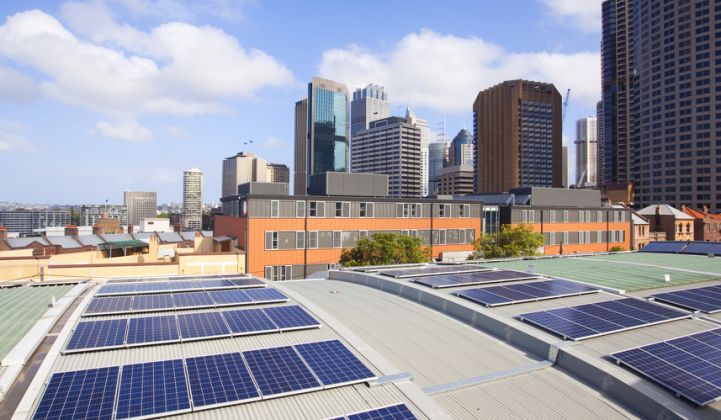Time-of-use rate changes are coming to California, with significant implications for commercial solar customers.
Regulators recently approved SDG&E’s proposal to shift time-of-use (TOU) peak periods from the solar-friendly hours of 11:00 a.m. to 6:00 p.m. to the less sunny hours of 4:00 p.m to 9:00 p.m. With that precedent in mind, regulators are now assessing similar proposals from SCE and PG&E, which are set be determined by the end of 2017. With projects being compensated at lower energy rates at peak hours of solar production, developers are bracing for a hit to project economics for C&I customers.
In a new research note, GTM Research partnered with BlueFlame Energy Finance to model 7,335 scenarios using nearly 500 different assumptions for irradiation, system size, rate class, and load profile across 16 different building types. The resulting analysis looks at the range of impacts a TOU shift will present to project economics and includes levelized PV savings by system size and offtaker types.
I sat down with GTM Research solar analyst and author of the note, Austin Perea, to discuss the analysis.
MM: At the highest level, what did the study find about commercial solar economics?
AP: Under old TOU periods, customers with high daytime exports saw the best savings. Under new TOU periods, customers that export most of their solar during the day at lower off-peak rates and then have a higher evening load will suffer from peak pricing being pushed back.
Ultimately, the most attractive customer is one with a spikier load profile in the late afternoon, when solar production overlaps with the onset of on-peak pricing or customers that are self-consuming a larger share of production during off-peak (i.e., sunnier) times of the day and have minimal to no nighttime load.
There is no question that project economics are worsening for commercial customers under the new TOU shift. However, the economics still pan out for the vast majority of projects. Under old TOU periods, over half of the scenarios we modeled saw 30 percent or higher gross year-one savings, which means for cash deals customers are seeing a sub-four-year payback. When we ran the data with the revised TOU periods, 44 percent of scenarios still see 30 percent gross year-one savings.

MM: Which building type offers the best solar economics?
AP: Across system size ranges, primary schools would remain the most attractive customer segment. Schools have always been a high-value customer due to high summer exports at previously solar-friendly peak periods. With revised TOU periods, most summer production would be compensated at off-peak and partial-peak rates, which significantly decreases the value proposition. However, primary schools’ new levelized avoided cost (at $0.18 per kilowatt-hour) would now be on par with average savings across other customers under old TOU, which would typically have seen the second-best savings after primary schools. Under new TOU periods, schools continue to be the highest-value customer in theory, though in practice the pool of large schools is mostly tapped.
MM: Beyond schools, what other building types will see greater savings under the new TOU shift?
AP: While primary schools are the most attractive under old or new TOU rates, there’s actually a pretty major change for some other building types. Under the shift, medium-sized office buildings now can yield the second-most savings across all 16 building types analyzed.
However, there are some customers that will no longer be in money. For instance, using the $0.10-$0.12 per kilowatt-hour range as a benchmark for competitive PPA pricing, large hotels will no longer see savings if the IOU’s proposals are implemented as they currently exist.
MM: What do TOU rate structure reforms mean for California’s commercial solar market as a whole?
AP: Despite savings propositions worsening across all market segments and customer types, non-residential solar remains viable in California under proposed TOU rates for PG&E. With competitive PPAs in California ranging from $0.10-$0.12 per kilowatt-hour, all the sub-250 kilowatt market, and most of the 250-1,000 kilowatt market segment, can still pitch 10 to 20 percent year-one savings or more to greater than half of the market under revised TOU periods.
We expect the market to fall in 2018 as a function of these period changes and the resulting impact to savings in addition to the closure of certain solar-friendly rate structures. But with TOU period changes upending the conventional narrative about which customers are most attractive, the post-2018 reboot will be driven by a more diverse set of customer types as revised TOU periods expand the universe of attractive customers beyond schools.
***
Austin Perea is an analyst for GTM Research covering downstream demand for the U.S. solar market. Prior to joining GTM Research, Austin worked at The Boston Consulting Group, where he supported the energy practice as a research associate.
If you subscribe to GTM Research’s U.S. Distributed Solar Research Service, download the report in your account. If not, learn more about the subscription here.




